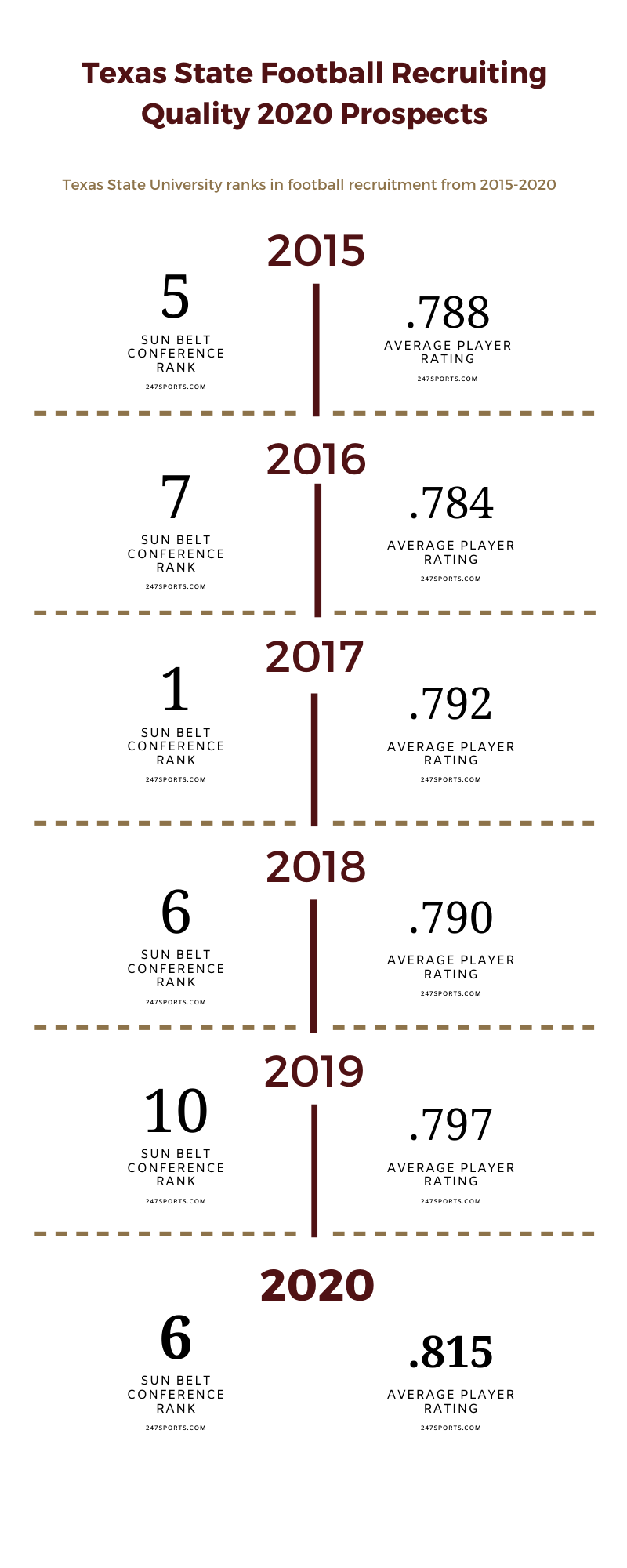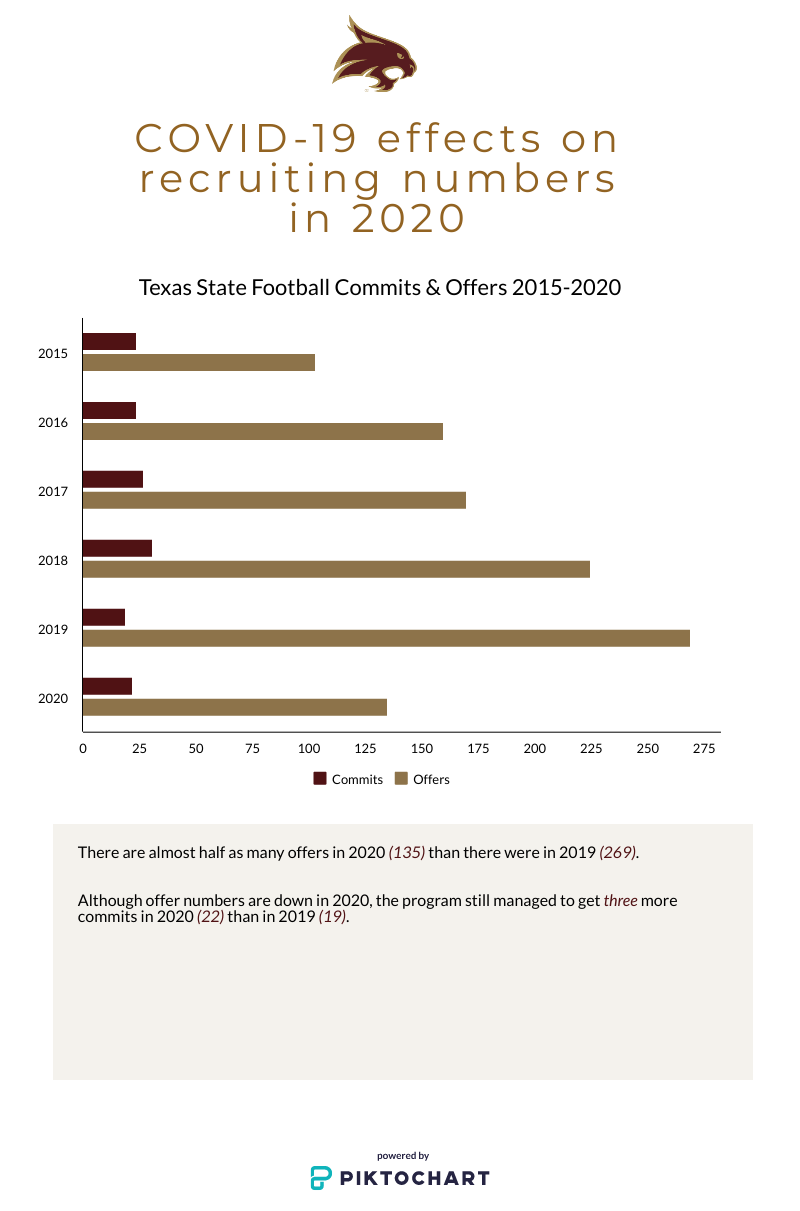Listeners:
Top listeners:
-
play_arrow
KTSW 89.9
How Texas State Football is Dealing with Changes from Coronavirus
todayApril 28, 2020

By Adam Keehn
Sports Reporter
Just as recruiting heated up and spring practices were beginning, college campuses all over the United States were shut down due to COVID-19, leaving the future of college sports in a place of uncertainty.
The novel coronavirus has brought about new challenges in the way of academics and the handling of recruitment, including how conditioning and practices will be made up to keep the program on the right track.
On March 19, Texas State University President Denise M. Trauth announced the decision to move all classes online through the end of the spring semester.
The uncertainty of how classes would continue to operate left students wondering if they were equipped with the technological tools needed to succeed– the Texas State football players are no exception to these issues.
Student-athletes were required to return home and complete their spring courses online and are required to pass their classes and do their work, even though some may not have access to WiFi or computers.
According to head coach Jake Spavital, the coaching staff is making it a priority to make sure the athletes have what they need to be able to do their work.
“Our number one thing right now is making sure that we’re getting the resources available, make sure that they have everything that they need to be able to pass their classes,” Spavital said. “There are a lot of checks and balances going on.”
The next thing to consider is how the cancellations have affected recruiting. According to Brant Freeman, a long time Texas State radio and TV play by play broadcaster, Spavital already had a good start to recruiting before the shutdown.
Texas State signed the highest quality prospects since 2015 with an average player rating of .815.
“He just had a really impressive recruiting class including guys that have power five backgrounds. He went and recruited a lot of size,” Freeman said. “I think people are excited about what this team could be next year.”

Someone excited about what the team could be next year is junior college transfer, Alex Costilla.
While at Tyler Junior College, Costilla was named one of the top 24 junior college recruits in Texas by Scout.com. After receiving offers from Nebraska, Louisville and Missouri, Costilla, a San Marcos native, committed to play offensive tackle for the Bobcats on December 19, 2019.
“When you feel what coach Spav is doing, you want to be a part of it and you want to be the change for a program,” Costilla said. “This will be a good year for us because of all the recruiting he and his coaching staff did. All these players are going to make a difference.”
Bringing in recruits that improve Texas State’s talent is not all the coaching staff wanted to do this offseason. Freeman explained that they have placed a major emphasis on getting standout recruits to change the losing culture of the program.
“One of the things that bothered coach Spavital is that some players have become so accustomed to losing. That part of the culture needs to change,” Freeman said. “The expectation isn’t to go out there and play hard, it’s to go out and play hard and win games.”
Another Bobcat recruit who wants to change the culture is three-star running back Issiah Nixon from Missouri City, Texas. Nixon will be a freshman at Texas State next year and expressed his optimism for the program.
“I knew Texas State is where I wanted to be,” Nixon said. “I’m excited for this season because I feel like the guys that were brought in can really make a difference in the team right away and change the name of Texas State football.”
But in the wake of the COVID-19 news, recruiting tactics have inevitably changed. The coaches will no longer get to evaluate players in their spring practices and potential recruits will not get campus visits, nor will they get face-to-face meetings with coaches.
During his March press conference, Spavital talked about how they have had to change their ways.
“We’re really just building databases of people we love, staying in contact with people that we’ve offered, people that we’re on. But also creating a hotlist of guys that have potential offers,” Spavital said. “You’re just kind of missing the evaluation part of it so whenever they give us that time to eval where we need to go see it in person, we’ve already got to kind of map them out.”

Since 2015, both commitments and offers for Texas State football have increased, but due to the coronavirus, there are almost half as many offers in 2020 than there were in 2019. Although the offer numbers are down, the program still managed to sign three more players this year than in 2019.
To evaluate recruits, the coaching staff are discussing them through video conferencing. Though COVID-19 has changed the way offseason recruiting is being handled, Spavital showed his optimism in the press conference.
“I’m a pretty big glass-half-full type of guy. I think it can also help us a lot,” Spavital said. “I think this is a unique time for us. So we’re putting a huge emphasis on making sure that we’re in constant contact with kids all day.”
Every spring, most NCAA football programs are allowed 15 practices. It gives the coaches a chance to implement an offensive and defensive strategy that assess their personnel. Texas State had completed five of their spring practices, while some conference competition has completed all 15.
Even though five practices doesn’t sound like a lot, Spavital made it a point to get as much implemented as possible and believes they made great strides. He talked about it at a press conference in late March.
“We’ve got to put everything in. Even if their heads are spinning, we’ve got to get the installs in,” Spavital said. “We’ve got like 90% of the offense in right now. I think they’ve gotten a taste of what it’s supposed to look like.”
Although Spavital was pleased with the practices they had, conference opponents like Arkansas State and Coastal Carolina still have ten more practices under their belt. The next step is uncertain, but Texas State could get to make up the practices in some way, shape, or form.
During a press conference on March 26, Spavital said he heard that they could do OTA’s (organized team activities) in June, just like the NFL does.
Another challenge is how the athletes will stay conditioned and ready for when the time comes to return to the field. When things are normal, athletes stay in shape with practices and workouts throughout the week.
Now that practices aren’t happening, it is up to the athletes– with little supervision from coaches–to put the work in.
The coaching staff has made sure they are communicating with the players and making sure that players stay on top of their conditioning. Clay McGuire, Texas State’s offensive line coach, has been in contact with players like offensive line recruit, Trenton Scott.
“The communication between me and coach McGuire is good, we text every other day,” said Scott. “I’m keeping up with conditioning very well. I work out every day and I run three times a week.”
If things were normal today, Texas State football would be playing their spring games and preparing for the 2020 season. If things progress and the season plays out, Texas State is set to host SMU at Bobcat Stadium in San Marcos on September 5.
Keeping the athletes engaged, working hard and with the right mindset during this time could put the Bobcats in a position to succeed when the season begins, whenever that may be.
Featured image by Nathan Rarangol.
Share this:
- Click to share on Twitter (Opens in new window)
- Click to share on Facebook (Opens in new window)
- Click to share on Tumblr (Opens in new window)
- Click to share on Pinterest (Opens in new window)
- Click to share on Reddit (Opens in new window)
- Click to email a link to a friend (Opens in new window)
- Click to print (Opens in new window)
adam keehn Bobcat Football Bobcats Texas State Football Texas State University
Similar posts
This Blog is Propery of KTSW



Post comments (1)